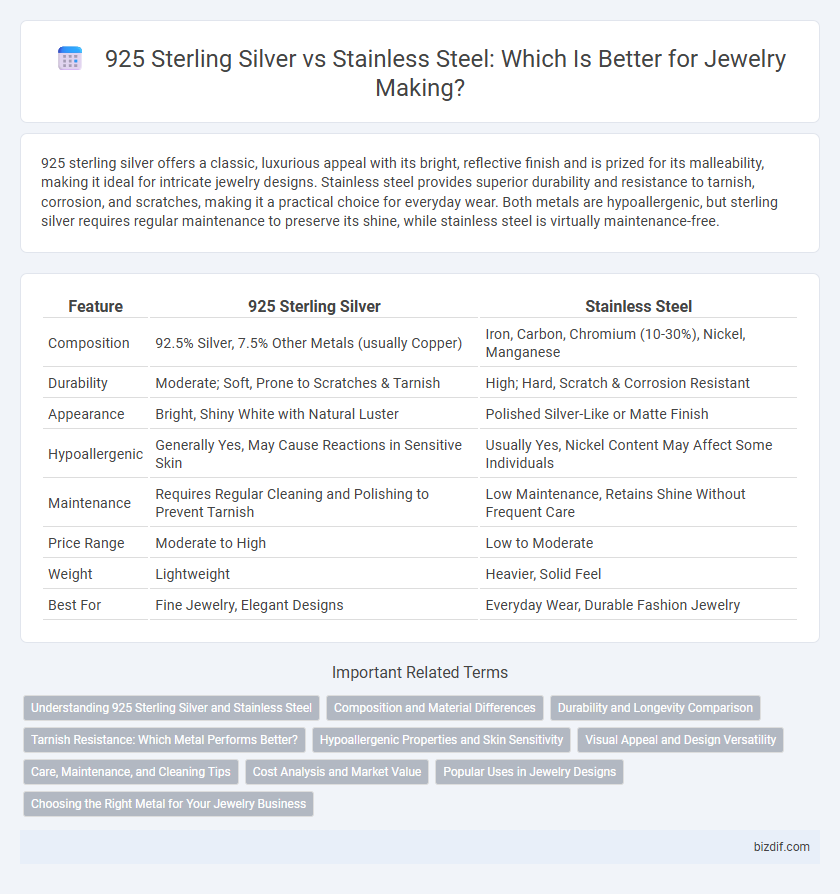925 sterling silver offers a classic, luxurious appeal with its bright, reflective finish and is prized for its malleability, making it ideal for intricate jewelry designs. Stainless steel provides superior durability and resistance to tarnish, corrosion, and scratches, making it a practical choice for everyday wear. Both metals are hypoallergenic, but sterling silver requires regular maintenance to preserve its shine, while stainless steel is virtually maintenance-free.
Table of Comparison
| Feature | 925 Sterling Silver | Stainless Steel |
|---|---|---|
| Composition | 92.5% Silver, 7.5% Other Metals (usually Copper) | Iron, Carbon, Chromium (10-30%), Nickel, Manganese |
| Durability | Moderate; Soft, Prone to Scratches & Tarnish | High; Hard, Scratch & Corrosion Resistant |
| Appearance | Bright, Shiny White with Natural Luster | Polished Silver-Like or Matte Finish |
| Hypoallergenic | Generally Yes, May Cause Reactions in Sensitive Skin | Usually Yes, Nickel Content May Affect Some Individuals |
| Maintenance | Requires Regular Cleaning and Polishing to Prevent Tarnish | Low Maintenance, Retains Shine Without Frequent Care |
| Price Range | Moderate to High | Low to Moderate |
| Weight | Lightweight | Heavier, Solid Feel |
| Best For | Fine Jewelry, Elegant Designs | Everyday Wear, Durable Fashion Jewelry |
Understanding 925 Sterling Silver and Stainless Steel
925 Sterling Silver, composed of 92.5% pure silver and 7.5% other metals, is prized for its lustrous appearance and malleability, making it ideal for intricate jewelry designs. Stainless steel, an alloy primarily of iron, chromium, and nickel, offers exceptional durability, resistance to tarnish, and hypoallergenic properties, suitable for everyday wear. Understanding these materials' composition and characteristics helps jewelers select the appropriate metal for both aesthetic appeal and functional longevity.
Composition and Material Differences
925 Sterling Silver consists of 92.5% pure silver alloyed with 7.5% copper to enhance durability and maintain its lustrous appearance, making it a preferred choice for high-quality jewelry. Stainless steel is an alloy primarily composed of iron, chromium (at least 10.5%), and other metals like nickel and molybdenum, offering superior resistance to corrosion and tarnishing compared to silver. The key material difference lies in sterling silver's softness and susceptibility to oxidation versus stainless steel's strength, hypoallergenic properties, and low maintenance.
Durability and Longevity Comparison
925 Sterling Silver offers elegant shine but is softer and more prone to scratches and tarnishing compared to stainless steel. Stainless steel jewelry boasts superior durability, resisting corrosion, rust, and everyday wear, making it ideal for long-term use. The longevity of stainless steel often surpasses sterling silver, especially for active lifestyles or frequent exposure to moisture.
Tarnish Resistance: Which Metal Performs Better?
925 Sterling Silver, composed of 92.5% pure silver and 7.5% other metals, is prone to tarnishing due to its high silver content reacting with sulfur and moisture in the air. Stainless steel, an alloy primarily made of iron, chromium, and nickel, offers superior tarnish resistance because of its chromium oxide layer that prevents corrosion and discoloration. For jewelry making, stainless steel is preferred when durability and low maintenance are priorities, while 925 Sterling Silver is chosen for its classic luster despite requiring regular polishing to maintain its appearance.
Hypoallergenic Properties and Skin Sensitivity
925 Sterling Silver is renowned for its hypoallergenic qualities due to its high purity level of 92.5% silver mixed primarily with copper, minimizing the risk of skin reactions. Stainless steel, especially surgical grade 316L, is also hypoallergenic and highly resistant to tarnish and corrosion, making it an excellent choice for sensitive skin and everyday wear in jewelry making.
Visual Appeal and Design Versatility
925 Sterling Silver offers a bright, lustrous finish that enhances intricate jewelry designs with its smooth texture and reflectivity, making it ideal for detailed craftsmanship. Stainless steel provides a sleek, modern look with a slightly darker tone, excelling in durable, minimalist styles that resist tarnish and maintain their shine. Both metals support diverse design aesthetics, but sterling silver excels in ornate, classic pieces while stainless steel suits bold, contemporary creations.
Care, Maintenance, and Cleaning Tips
925 Sterling Silver requires regular polishing with a soft cloth and occasional cleaning with a silver-specific cleaner to prevent tarnish and maintain its shine. Stainless steel is highly durable, corrosion-resistant, and can be cleaned easily with soap and water without special products. Both metals benefit from storing in dry, airtight containers to minimize exposure to moisture and air that accelerate oxidation or tarnishing.
Cost Analysis and Market Value
925 Sterling Silver typically costs more than stainless steel due to its higher precious metal content, with prices influenced by silver market rates averaging around $0.70 per gram. Stainless steel offers a lower-cost alternative, priced roughly between $0.05 to $0.15 per gram, making it more accessible for mass market jewelry. In terms of market value, sterling silver jewelry retains intrinsic worth due to its silver content, while stainless steel is favored for durability and affordability but lacks substantial resale value.
Popular Uses in Jewelry Designs
925 sterling silver is favored for intricate jewelry designs such as rings, bracelets, and pendants due to its malleability and bright luster. Stainless steel is popular in modern and unisex jewelry, including watches, chains, and earrings, valued for its durability and resistance to tarnish. Both materials are extensively used in crafting stylish, affordable, and hypoallergenic accessories.
Choosing the Right Metal for Your Jewelry Business
Choosing the right metal for your jewelry business hinges on factors like durability, appearance, and customer preferences. 925 Sterling Silver offers timeless elegance and high malleability, ideal for intricate designs but requires regular polishing to prevent tarnish. Stainless steel boasts superior corrosion resistance and affordability, appealing to customers seeking modern, low-maintenance jewelry options.
925 Sterling Silver vs Stainless Steel Infographic

 bizdif.com
bizdif.com